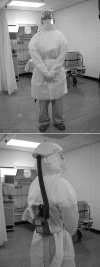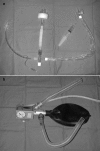SARS: ventilatory and intensive care
- PMID: 15018131
- PMCID: PMC7169203
- DOI: 10.1046/j.1440-1843.2003.00521.x
SARS: ventilatory and intensive care
Abstract
Severe acute respiratory syndrome (SARS) is an emerging infection caused by a novel coronavirus. It is characterised by a highly infectious syndrome of fever and respiratory symptoms, and is usually associated with bilateral lung infiltrates. The clinical syndrome of SARS often progresses to varying degrees of respiratory failure, with about 20% of patients requiring intensive care. Despite concern about potential aerosol generation, non-invasive ventilation (NIV) has been reported to be efficacious in the treatment of SARS-related ARF without posing infection risks to health care workers (HCW). Spontaneous pneumomediastinum and pneumothorax in SARS is common. The incidence of NIV-associated barotrauma ranged from 6.6% to 15%. Patients who fail to tolerate NIV or fail NIV with progressive dyspnoea, tachypnoea and hypoxaemia should be intubated and mechanically ventilated. Mortality rates in intensive care units for SARS patients were high: 34-53% at 28 days, when some patients were still being ventilated. Strict adherence to infection control measures including isolation, use of appropriate personal protective equipment and negative pressure environment had been reported to eliminate cross-infection to HCW.
Figures


Similar articles
-
Critically ill patients with severe acute respiratory syndrome.JAMA. 2003 Jul 16;290(3):367-73. doi: 10.1001/jama.290.3.367. JAMA. 2003. PMID: 12865378
-
Intensive care for seriously ill patients affected by novel coronavirus sars - CoV - 2: Experience of the Crema Hospital, Italy.Am J Emerg Med. 2021 Jul;45:156-161. doi: 10.1016/j.ajem.2020.08.005. Epub 2020 Aug 16. Am J Emerg Med. 2021. PMID: 33046317 Free PMC article.
-
Pneumothorax and mortality in the mechanically ventilated SARS patients: a prospective clinical study.Crit Care. 2005 Aug;9(4):R440-5. doi: 10.1186/cc3736. Epub 2005 Jun 22. Crit Care. 2005. PMID: 16137358 Free PMC article.
-
Mechanical ventilation in an airborne epidemic.Clin Chest Med. 2008 Jun;29(2):323-8, vii. doi: 10.1016/j.ccm.2008.01.001. Clin Chest Med. 2008. PMID: 18440440 Free PMC article. Review.
-
COVID-19 pandemic and non invasive respiratory management: Every Goliath needs a David. An evidence based evaluation of problems.Pulmonology. 2020 Jul-Aug;26(4):213-220. doi: 10.1016/j.pulmoe.2020.04.013. Epub 2020 Apr 27. Pulmonology. 2020. PMID: 32362507 Free PMC article. Review.
Cited by
-
COVID-19 versus SARS: A comparative review.J Infect Public Health. 2021 Jul;14(7):967-977. doi: 10.1016/j.jiph.2021.04.007. Epub 2021 Apr 24. J Infect Public Health. 2021. PMID: 34130121 Free PMC article. Review.
-
Pneumomediastinum and Pneumothorax as Relevant Complications of Sub-Intensive Care of Patients with COVID-19: Description of a Case Series.Medicina (Kaunas). 2021 Sep 1;57(9):919. doi: 10.3390/medicina57090919. Medicina (Kaunas). 2021. PMID: 34577842 Free PMC article.
-
Emergency tracheal intubation in 202 patients with COVID-19 in Wuhan, China: lessons learnt and international expert recommendations.Br J Anaesth. 2020 Jul;125(1):e28-e37. doi: 10.1016/j.bja.2020.03.026. Epub 2020 Apr 10. Br J Anaesth. 2020. PMID: 32312571 Free PMC article.
-
Preparing your intensive care unit for the COVID-19 pandemic: practical considerations and strategies.Crit Care. 2020 May 11;24(1):215. doi: 10.1186/s13054-020-02916-4. Crit Care. 2020. PMID: 32393325 Free PMC article. Review.
-
Bleeding in COVID-19 severe pneumonia: The other side of abnormal coagulation pattern?Eur J Intern Med. 2020 Jul;77:147-149. doi: 10.1016/j.ejim.2020.05.002. Epub 2020 May 7. Eur J Intern Med. 2020. PMID: 32414639 Free PMC article. No abstract available.
References
-
- Fowler RA, Lapinsky SE, Hallet D et al. Critically ill patients with severe acute respiratory distress syndrome. JAMA 2003; 290: 367–73. - PubMed
-
- Lew TWK, Kwek T, Tai D et al. Acute respiratory distress syndrome in critically ill patients with severe acute respiratory syndrome. JAMA 2003; 290: 374–80. - PubMed
-
- Lee N, Hui D, Wu A, Chan P et al. A major outbreak of severe acute respiratory syndrome in Hong Kong. N. Engl. J. Med. 2003; 348: 1986–94. - PubMed
-
- Booth CM, Matukas LM, Tomlinson GA et al. Clinical features and outcomes of 144 patients with SARS in the greater Toronto area. JAMA 2003; 289: 2801–9. - PubMed
-
- Xiao ZL, Li YM, Chen RC, Li SY, Zhong SQ, Zhong NS. A retrospective study of 78 patients with severe acute respiratory syndrome. Chin. Med. J. 2003; 116: 805–10. - PubMed
Publication types
MeSH terms
LinkOut - more resources
Full Text Sources
Medical
Miscellaneous

